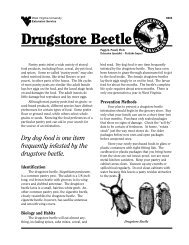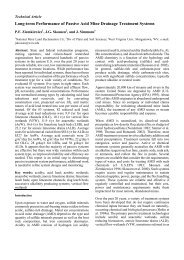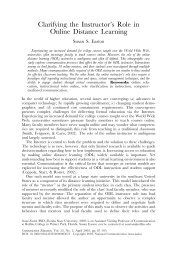Rediscover Forgotten Root Crops - West Virginia University
Rediscover Forgotten Root Crops - West Virginia University
Rediscover Forgotten Root Crops - West Virginia University
You also want an ePaper? Increase the reach of your titles
YUMPU automatically turns print PDFs into web optimized ePapers that Google loves.
<strong>Rediscover</strong> <strong>Forgotten</strong> <strong>Root</strong> <strong>Crops</strong><br />
Larry G. Campbell, WVU Extension Agent, Harrison County<br />
Educational<br />
Objectives<br />
1. To make home<br />
gardeners aware<br />
of the fact that<br />
growing root crops<br />
is an excellent<br />
way to extend the<br />
growing season<br />
and provide a<br />
variety of nutritious<br />
vegetables from the<br />
backyard garden.<br />
2. To increase<br />
the gardener’s<br />
appreciation<br />
for unique root<br />
crops that have<br />
been a part of<br />
our gardening<br />
heritage but have<br />
been forgotten or<br />
neglected in<br />
recent years.<br />
<strong>Root</strong> crops are valuable additions to the backyard garden because they expand<br />
a garden’s productivity. They extend the growing season – many root crops<br />
actually taste better after a fall frost. They require little space to grow and<br />
have a long storage life.<br />
Valuable root crops that are<br />
a part of our rich gardening<br />
heritage have become the<br />
“forgotten root crops.” These<br />
vegetables include celeriac,<br />
horseradish, parsnips,<br />
rutabagas, turnips, salsify,<br />
and leeks.<br />
Planting<br />
and Culture<br />
<strong>Root</strong> crops need well-drained,<br />
deeply tilled, loose soil to<br />
produce their best. Adding<br />
compost can help improve the<br />
tilth of heavy soils; however,<br />
coarse organic matter should<br />
not be added immediately<br />
before planting since this<br />
can cause parsnips and other<br />
roots to split and fork. Using<br />
raised beds 4 to 6 inches deep<br />
and deep cultivation can help<br />
to overcome the deficiencies of<br />
heavy soils. Raised beds allow<br />
for easier digging at harvest<br />
and let long-rooted crops such<br />
as parsnips and salsify grow<br />
longer and smoother.<br />
<strong>Root</strong> crops are not generally limited by soil pH. However, if the fungal disease,<br />
club root, is present, a pH of 7 is best for turnips and rutabagas. A soil test of<br />
the planting site will specifically address both pH and fertility needs.<br />
WVU Extension Service Families and Health Programs<br />
WLG 151<br />
– continued –
Crop<br />
Celeriac<br />
Horseradish<br />
Parsnip<br />
Rutabaga<br />
Salsify<br />
Turnip<br />
Leek<br />
Seed/Plants<br />
per 10’ of Row<br />
20-30 plants<br />
5 sets<br />
1 packet<br />
1/8 packet<br />
1/3 packet<br />
1/8 packet<br />
1/2 packet<br />
Spacing in<br />
Row (inches)<br />
Celeriac<br />
Celeriac is a variant of the common celery.<br />
It is also known as knob celery or turnip-rooted<br />
celery because of the large turnip-like swelling<br />
at the base of the plant. This bulbous base, which<br />
grows to 4 inches in diameter, is the commonly<br />
eaten part of the plant.<br />
Celeriac is a member of the parsley family, which<br />
includes carrots, celery, parsnips, and dill. It was<br />
used by the Egyptians, Greeks, and Romans for<br />
religious purposes. It was used in the Middle Ages<br />
primarily as a vegetable plant and is popular today<br />
with Europeans who eat it raw in salads or cooked<br />
in soups or stews.<br />
Few gardeners try this root crop because of its<br />
long growing season. It is best to use transplants<br />
started indoors 10 weeks before planting time. Such<br />
varieties as Giant Prague and Monarch are typically<br />
grown. Because celeriac is a heavy feeder, two or<br />
more applications of fertilizer during the growing<br />
season are recommended. Side shoots and withered<br />
leaves should be removed when they appear. Plants<br />
can be blanched by slightly hilling them about two<br />
weeks before harvest.<br />
Celeriac will attain its best flavor after the first<br />
frost. It may be left in the garden to be harvested as<br />
needed or pulled and stored in a cool place for up to<br />
six months. The root should be peeled before use. It<br />
can be eaten raw, but it is often cooked like potatoes.<br />
4-6<br />
24<br />
3-6<br />
5-8<br />
2-4<br />
2-6<br />
4<br />
Spacing Between<br />
Rows (inches)<br />
24-30<br />
30<br />
18-30<br />
18-36<br />
18-30<br />
12-30<br />
24<br />
Planting<br />
Depth<br />
NA<br />
3-5<br />
When to<br />
Plant<br />
Early spring<br />
Spring<br />
Early spring<br />
Midsummer<br />
Early spring<br />
Early spring<br />
& late<br />
summer<br />
Seeds in late<br />
March or<br />
transplants<br />
in April<br />
WVU Extension Service Families and Health Programs<br />
1/2<br />
1/4-1/2<br />
1/2-1<br />
1/2<br />
1/4<br />
Days to<br />
Maturity<br />
100-110 or<br />
56-84 for<br />
transplants<br />
180<br />
100-130<br />
390-95<br />
150-155<br />
45-75<br />
100-120<br />
Yield per<br />
10’ Row<br />
6 lbs.<br />
3-7 lbs.<br />
10-12 lbs.<br />
8-10 lbs.<br />
10 lbs.<br />
10 lbs.<br />
6-7 lbs.<br />
Harvest<br />
Duration<br />
3-6 weeks<br />
1-2 months<br />
3-4 months<br />
1-2 months<br />
1-2 months<br />
2-3 weeks<br />
Late fall<br />
to early<br />
spring<br />
Horseradish<br />
Horseradish is a hardy perennial plant of the<br />
Brassicaceae family (formerly Cruciferae), which<br />
includes mustard and cabbages.<br />
Horseradish probably originated in southeastern<br />
Europe and western Asia. It has been used by the<br />
Egyptians and<br />
Greeks for more<br />
than 3,500 years.<br />
Both the root and<br />
leaves were used<br />
for medicinal<br />
purposes during<br />
the Middle Ages.<br />
It is commonly<br />
used today as a<br />
pungent condiment.<br />
<strong>Root</strong> cuttings<br />
called “sets” are<br />
used to produce<br />
horseradish.<br />
These slender<br />
8- to 14-inch roots<br />
are planted in the early spring in furrows 3 to 5<br />
inches deep. The sets are laid 18 to 24 inches apart,<br />
with the head (large end) slightly elevated and<br />
2 to 3 inches below the soil surface. The plants will<br />
grow 2 to 2-1/2 feet high, and the roots will make<br />
their best growth in early fall. Typical varieties are<br />
Maliner Kren, Big Top, and Hybrid Horseradish.
To produce the best roots, the top and side roots<br />
must be removed. This process, called “lifting,” can<br />
be done by gently lifting the crown end of the plant<br />
with a hoe to break off top and side roots. This forces<br />
the plant to form a longer, straighter root and side<br />
roots at the bottom of the root. Lifting should be<br />
done twice before midseason.<br />
Horseradish is best harvested in late fall. Remove<br />
pencil-size side roots and store in a cool place for<br />
planting as next year’s sets. Clean roots, trim the<br />
tops to within 1 inch of the crown, and wrap them<br />
in plastic for storage in the refrigerator.<br />
To process horseradish, peel and grate or grind<br />
the roots. Add 2 to 3 tablespoons of white vinegar<br />
(not cider vinegar, which discolors the horseradish)<br />
and 1/2 teaspoon of salt or 1 tablespoon of sugar.<br />
Parsnips<br />
Parsnips, another member of the parsley family,<br />
resemble an ivory-colored carrot. Parsnips, native<br />
to Europe and Asia, were popular with the ancient<br />
Romans. The plant was introduced to North<br />
America by the colonists in the 1600s.<br />
Plant parsnip seeds in early April in deep, fertile<br />
soil. The long, tender roots are easily checked and<br />
deformed by any resistance so the soil must be loose<br />
and well-prepared. Because parsnip seed has a<br />
poor rate of germination, sow it thickly. Use fresh<br />
seed since it is short-lived. Good varieties are All<br />
American, Hollow Crown, Harris Model, Cobham<br />
Improved Marrow, Andover, and Lancer.<br />
Parsnips taste best after exposure to near-freezing<br />
temperatures. Harvest roots that are 1-1/2 to 2<br />
inches in diameter. <strong>Root</strong>s can be left in the ground<br />
for harvesting throughout the winter if a few inches<br />
of soil cover the crowns.<br />
Parsnips can be roasted, cooked in butter, added<br />
to stew, used in soups, or boiled and mashed.<br />
Contrary to belief, parsnip roots are not poisonous.<br />
Rutabagas<br />
Rutabagas originated long ago from a cross<br />
between a turnip and a cabbage. Rutabagas have<br />
smooth, waxy, blue-green foliage and are generally<br />
yellow-fleshed. Rutabagas also have slower growth,<br />
longer storage life, and more vitamins A and C<br />
than the turnip.<br />
The name “rutabaga” comes from the Swedish word<br />
for “thick root,” rotabagge. It is commonly called<br />
WVU Extension Service Families and Health Programs<br />
“Swede turnip” in England and Canada. It has<br />
been used for food in Europe for more than 300<br />
years. It is reported that the first jack-o’-lanterns<br />
were made from carved rutabagas in Ireland.<br />
Rutabagas should be planted about 100 days before<br />
the first frost. If planted too early and allowed<br />
to mature in hot weather, they will become tough<br />
and bitter. Varieties to plant are American Purple<br />
Top, Laurentian, Pike, and Altasweet.<br />
Harvest rutabagas after they have been exposed to<br />
several light frosts. This will enhance the sweetness<br />
and flavor of the roots. Four- to 5-inch roots should<br />
be harvested. Trim off the foliage to within 1 inch<br />
of the crown. Rutabagas will keep for two to four<br />
months in cool storage. The roots can be left in the<br />
ground through early winter if heavy straw mulch<br />
is applied. The roots can be cooked, mashed with<br />
potatoes, and used in stews or casseroles.<br />
Turnips<br />
Turnips, like rutabagas, are members of the<br />
mustard family. Turnips are generally smaller than<br />
rutabagas and have light green, thin, hairy leaves.<br />
Most have white-fleshed roots that have little or no<br />
neck. They are quick to grow and can produce both<br />
spring and fall crops. The fall crop is usually larger<br />
and of higher quality and can be stored for winter<br />
use. Some turnips are grown only for their leaves or<br />
“greens,” which are rich in vitamins and minerals.<br />
Turnips grow wild in some places such as Siberia<br />
and have been used for food since prehistoric times.<br />
The turnip was first planted in North America in<br />
Canada in 1541, and the colonists planted it in<br />
<strong>Virginia</strong> in 1609.<br />
Plant turnips in the early spring for an early crop<br />
and in late summer for a fall crop. They grow best<br />
in rich, loose soil. If you grow leaf varieties for
greens, use a high-nitrogen fertilizer. Recommended<br />
varieties are Purple Top White Globe, Tokyo Cross,<br />
Just Right, Royal Crown,White Knight, and White<br />
Lady. For greens, try Seven Top, Shogoin, Alltop,<br />
and Topper.<br />
Salsify<br />
Salsify, native to the Mediterranean region, is<br />
cultivated for its edible, long, pale, white-skinned<br />
root. The mature root has been described as a<br />
sickly parsnip that is covered in small grassy<br />
sprouts. Salsify is also known as “Oyster Plant”<br />
or “Vegetable Oyster” because some people feel<br />
that it has a faint oyster-like flavor.<br />
The name “salsify” is derived from the French<br />
salsifis. It has been cultivated in Europe since<br />
about 1600 and was introduced into the United<br />
States before 1800.<br />
Plant salsify in the spring. Salsify is slow-growing<br />
and must be weeded and watered consistently.<br />
It is generally free from most disease and insect<br />
problems. There is little choice in variety other<br />
than Mammoth Sandwich Island.<br />
It can be harvested from October through April,<br />
provided it is mulched with straw to prevent<br />
freezing. Leaves should be cut off 1 inch above<br />
the root. They may be stored unwashed in plastic<br />
for up to a week in the refrigerator. Salsify is<br />
used in stews and casseroles or mashed, cooked,<br />
and deep-fried.<br />
Leeks<br />
Leeks, mild-flavored<br />
members of the onion<br />
family, resemble<br />
onion plants with flat<br />
leaves similar to<br />
garlic. Leeks do not<br />
form bulbs or cloves<br />
but produce an edible<br />
6- to 10-inch-long<br />
round stem about<br />
2 inches in diameter.<br />
The name “leek”<br />
comes from the<br />
Anglo-Saxon leac.<br />
Originally native to the Eastern Mediterranean area<br />
and Asia, leeks have been cultivated for more than<br />
3,000 years. They are never found wild. Leeks were<br />
known in Biblical times and were part of the diet<br />
WVU Extension Service Families and Health Programs<br />
of ancient Egyptians. The Romans were responsible<br />
for the spread of leeks throughout Europe and<br />
the British Isles. By 1775, leeks were being grown<br />
in America.<br />
Direct-seed leeks in March. Transplants should be<br />
planted in the garden in April. Technically not a<br />
root crop, leeks are grown for their thickened, white<br />
stalks. To produce these blanched stalks, 2 to 3<br />
inches soil should be banked up around the stems<br />
when they are pencil-size. This should be done two<br />
or three times during the season. Recommended<br />
varieties are American Flag, Dawn Giant, Titan,<br />
Carina, King Richard, and Jersey.<br />
Harvest leeks when they are at least 1 inch in<br />
diameter. Simply cut off the roots and all but<br />
2 to 4 inches of the top. If mulched heavily in the<br />
fall, many varieties will overwinter. Leeks can be<br />
used raw in salads, but most often they are used<br />
for flavoring soups and stews.<br />
Activity<br />
Try different recipes to appreciate the<br />
goodness of the “forgotten root crops.”<br />
References<br />
Celeriac. (n.d.) Retrieved July 12, 2006, from the Internet<br />
(www.arhomeandgarden.org/fruits_nuts_vegs/Vegetables/<br />
publications.htm).<br />
Drost, Dan. Leeks in the Garden. Utah State <strong>University</strong><br />
Extension Service Fact Sheet HG/2004. March 2004.<br />
Growing Your Own Vegetables. USDA Agriculture<br />
Information Bulletin 409. December 1977.<br />
Parsnip. (n.d.) Retrieved July 12, 2006, from the Internet<br />
(www.urbanext.uiuc.edu/veggies/parsnip1.html).<br />
Raymond, Dick. The Joy of Gardening. Garden Way Inc. 1982.<br />
Sanders, Douglas C. Home Garden Turnips and Rutabagas.<br />
North Carolina State <strong>University</strong> Extension Service Fact<br />
Sheet HIL-8026. December 1997.<br />
2006: 10M<br />
Programs and activities offered by the <strong>West</strong> <strong>Virginia</strong><br />
<strong>University</strong> Extension Service are available to all persons<br />
without regard to race, color, sex, disability, religion,<br />
age, veteran status, political beliefs, sexual orientation,<br />
national origin, and marital or family status. Issued<br />
in furtherance of Cooperative Extension work, Acts<br />
of May 8 and June 30, 1914, in cooperation with the<br />
U.S. Department of Agriculture. Director, Cooperative<br />
Extension Service, <strong>West</strong> <strong>Virginia</strong> <strong>University</strong>.<br />
ES06-155










